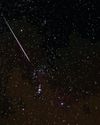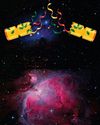Poging GOUD - Vrij
Surfing spacetime with LISA
BBC Sky at Night Magazine
|June 2024
A new era of gravitational wave astronomy is on its way as the ambitious upcoming LISA space mission joins a host of huge detectors on Earth. Charlie Hoy explains

In September 2015, some of the most sensitive instruments ever built made a remarkable discovery: the first-ever detection of tiny ripples in space and time, known as gravitational waves. Created by a pair of black holes spiralling towards each other and crashing together, the observed wave travelled through space at the speed of light until it was detected by two separate observatories here on Earth.
Now scientists are setting their sights on grander goals, hoping to observe the entire Universe, looking back in time to its very origin, with gravitational waves. In January 2024, the European Space Agency (ESA) gave the green light for an international team of scientists to begin building the largest gravitational wave detector ever built - only this time it will be in space. Its name is LISA, the Laser Interferometer Space Antenna, and it will revolutionise our understanding of the Universe.
Gravitational waves are ripples in space and time, similar to those formed on the surface of water when a pebble is dropped from a height. Gravitational waves, however, are caused by some of the most violent astrophysical events in the Universe, such as black holes smashing together. They were predicted by Albert Einstein in his general theory of relativity more than a century ago. According to theory, gravitational waves expand and contract spacetime itself. Everything, including you and me, will stretch and squeeze as a gravitational wave passes by. Thankfully, although gravitational waves are thought to be like tsunamis at the source, by the time they reach us here on Earth their effects are minuscule; so small, in fact, that gravitational waves produced by some of the most energetic events in the Universe are thought to only stretch and squeeze the entire Earth by a fraction of the width of an atom.

Dit verhaal komt uit de June 2024-editie van BBC Sky at Night Magazine.
Abonneer u op Magzter GOLD voor toegang tot duizenden zorgvuldig samengestelde premiumverhalen en meer dan 9000 tijdschriften en kranten.
Bent u al abonnee? Aanmelden
MEER VERHALEN VAN BBC Sky at Night Magazine

BBC Sky at Night Magazine
How to photograph the Geminids
Dramatic meteor photos aren't just down to luck. We show you how to bag one
3 mins
December 2025

BBC Sky at Night Magazine
10 Christmas crackers for your new telescope
So Santa brought you a telescope - what now? Stuart Atkinson sprinkles some cosmic sparkle, with 10 sights to see over one fabulous festive night - from glorious galaxies and planets to glittering star clusters
7 mins
December 2025

BBC Sky at Night Magazine
10 years of reusable rockets
Ben Evans charts the rise of multi-flight spacecraft, the tech revolution that's transforming our access to space
6 mins
December 2025

BBC Sky at Night Magazine
SKILLS FOR STARGAZERS
Take great photos of the Milky Way
3 mins
December 2025

BBC Sky at Night Magazine
Smart scopes: from backyard to big science
Home-based stargazers are helping scientists crack some of the Universe's big mysteries - and you can join them. Charlotte Daniels shows us how
6 mins
December 2025

BBC Sky at Night Magazine
FIELD OF VIEW
Forget Instagram – embrace the moment
2 mins
December 2025

BBC Sky at Night Magazine
Q&A WITH A PLANETARY LIFE EXPERT
Saturn's icy moon Enceladus boasts water, heat and organics. Now scientists have discovered it has complex chemistry too. Could it prove to be habitable?
3 mins
December 2025

BBC Sky at Night Magazine
INSIDE THE SKY AT NIGHT
When The Sky at Night joined Curious Cases for a special episode, George Dransfield was there to answer your burning questions. Here she dives deeper into her favourite
3 mins
December 2025

BBC Sky at Night Magazine
Students fix JWST's blurry vision
PhD researchers restore the telescope's ultra-precise imaging - without a spacewalk
1 min
December 2025

BBC Sky at Night Magazine
On a Mission
This is an inspiring tribute to the trailblazing women who shaped NASA's human spaceflight programmes.
1 mins
December 2025
Listen
Translate
Change font size

